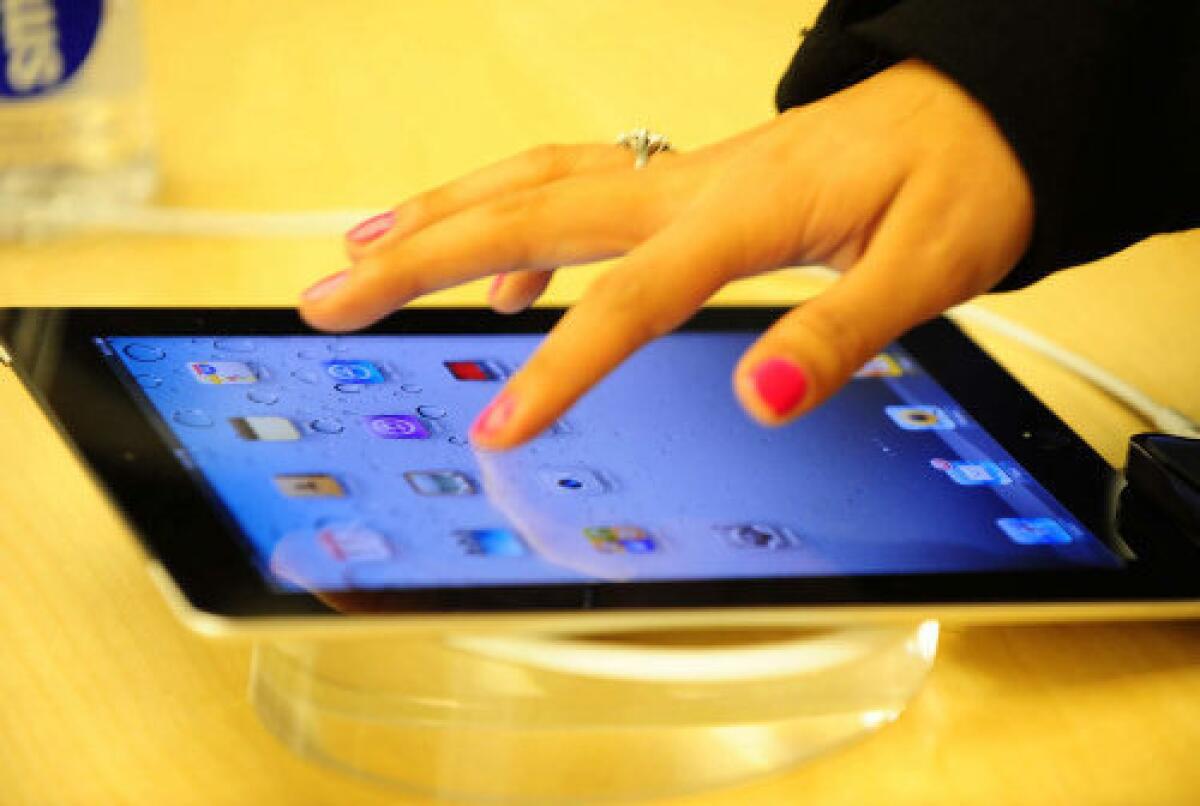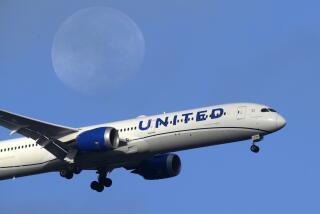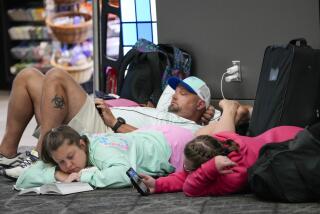Wi-Fi in the sky still cloudy, sometimes costly as airlines try to catch up with technology

- Share via
Logging on to most airline Wi-Fi networks feels like stepping into a time machine — and we don’t mean that in a good way. On many domestic flights, the bandwidth is barely ample enough for checking email, never mind streaming videos.
That’s partly by design. In 2008 and 2009, when many airlines were first adding Wi-Fi, the networks were designed for business travelers. They were carrying Blackberries, not iPhones, and most needed only a basic connection. Instead of satellites, these systems rely on ground-based cell towers that point at an antenna on the plane’s belly. When too many passengers log-on, the technology gets overwhelmed.
Most U.S. airlines are sticking with what they have on planes that already have Internet. Adding new technology is expensive, and airlines must pull planes from service to add it.
But increasingly, especially on new deliveries and planes that never had Wi-Fi, U.S. carriers are installing faster options that rely on satellite connections. With a few exceptions — mainly JetBlue and Virgin America — airlines still block streaming, but passengers should find the updated experience more closely mirrors what they have at home.
Because airlines do nothing quickly, even on carriers that are upgrading Wi-Fi, you won’t find speedy platforms on every plane. Also, some airlines have multiple Wi-Fi providers, so the experience (and, often, the price) will be different depending on the plane.
Spirit, Hawaiian, Allegiant and Frontier do not offer Wi-Fi. Here’s how other U.S. airlines compare.
JetBlue
How many planes: All Airbus A320s and A321s. JetBlue’s 60 Embraer 190s, which fly shorter routes, will have Wi-Fi by fall 2016.
Type of coverage: Satellite.
Caveats: Some Caribbean routes lack Wi-Fi over water.
Cost: Free for most uses. $9 to access a virtual private network or VPN.
Streaming via Wi-Fi: Yes.
Special feature: JetBlue passengers can watch every regular season Major League Baseball game for free on their computer, tablet or smartphone.
Southwest
How many planes: About 80% of fleet, but not Boeing 737-300s and 737-500s, older models that usually fly short routes.
Type of coverage: Satellite.
Caveats: Wi-Fi is available on international flights but not always for the entire time.
Cost: $8 per device per day.
Streaming via Wi-Fi: Access to high-bandwidth sites is not permitted, including Netflix.
Special feature: Customers receive 23 channels of free live TV to stream on their devices.
United
How many planes: More than 90% of United’s larger planes. All United Express jets with more than 50 seats also will soon have Wi-Fi.
Caveats: United has three providers, all with different speeds. On 737s, coverage isn’t available outside the continental U.S. Travelers who must have Wi-Fi should avoid United’s smallest 737s, the 737-700. Those planes won’t be fully connected until June
Type of coverage: Slower Gogo cell tower-based system on United Express and some 757s. Satellite on other aircraft.
Cost: Varies. Starts at $1.99 at hour.
Streaming via Wi-Fi: Generally not permitted.
Special feature: On some aircraft, United offers passengers free movies and TV shows streamed to their devices. If you’re using a phone or tablet, be sure to download United’s app before the flight or the feature will not work.
American
How many planes: Available on more than 95% of domestic flights. All Boeing 787s, Boeing 777-300ERs and some Boeing 777-200s flying internationally have Wi-Fi. Few American Eagle planes have Internet, but by next year nearly 250 regional jets will have it.
Caveats: Wi-Fi does not work on most flights from Los Angeles to Hawaii.
Type of coverage: Slower Gogo system on domestic flights. Satellite on international aircraft.
Cost: For most domestic flights, a Gogo all-day pass costs $16 with advance purchase. For longer international routes, American charges $19 a flight.
Streaming via Wi-Fi: Generally not permitted.
Special feature: On most domestic flights, T-Mobile customers receive free texting.
Virgin America
How many planes: All.
Caveats: A partnership with Netflix allows passengers to watch streaming content. By year’s end, however, only five planes will have Internet fast enough to support it. Also, in the short term, there’s no Hawaii coverage. No way to know just yet which planes have what Wi-Fi.
Type of coverage: Most planes have Gogo’s basic domestic Internet, but 10 planes to be delivered this year and next will have a faster satellite Internet.
Cost: Virgin America is testing satellite Wi-Fi until March, so passengers receive free access on the few planes that have it. More than 50 planes retain Gogo. For those flights, a day pass costs $16 with advance purchase.
Streaming via Wi-Fi: Only on planes delivered after summer 2015.
Special feature: On satellite-equipped planes, passengers have free access to Spotify, a music streaming site, through March 2.
Alaska
How many planes: All 737s except a small fleet of combination passenger/cargo planes that fly mainly in Alaska. On regional planes, only Embraer E175s have Wi-Fi.
Caveats: No coverage to Hawaii or Mexico. Many older 737s still have a first-generation Gogo system, the slowest in the air.
Type of coverage: Gogo’s cell tower-based service.
Cost: $16 per day with advance purchase.
Streaming via Wi-Fi: No
Special feature: Alaska allows you to stream some movies and TV shows from a server on the plane. Prices start at $1.99.
Delta
How many planes: About 1,000 Delta and Delta Connection planes. If a Delta domestic flight has a first-class section, it should also have Wi-Fi. About 71% of the international fleet has Wi-Fi, and all planes should have it by the middle of 2016.
Caveats: Domestic speeds can be slow, but a new satellite system developed by Gogo should boost bandwidth considerably. Delta has committed to adding that system to 250 jets starting the middle of next year.
Type of coverage: Gogo’s cell tower-based system on most U.S. flights. Satellite on many international flights.
Streaming: Generally not, but that may change.
Cost: An advance purchase all-day pass costs $16 for domestic flights and $28 for international.
Special feature: Delta lets passengers stream movies and TV shows from a server on board the aircraft.
More to Read
Sign up for The Wild
We’ll help you find the best places to hike, bike and run, as well as the perfect silent spots for meditation and yoga.
You may occasionally receive promotional content from the Los Angeles Times.






